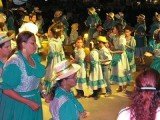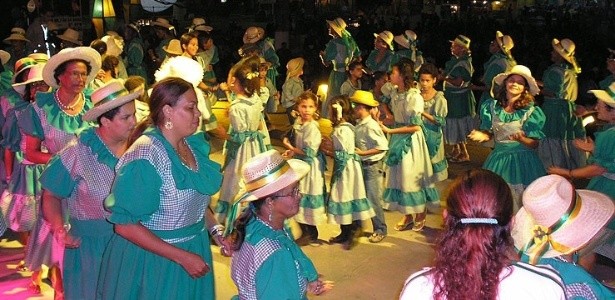Este post também está disponível em:
Português
English

The style of forró has gone through three major phases since it emerged in the 1940s. Evolution causes dispute, but formats can coexist, say critics.
This week begins the main moment of the forró marathon at the São João festivities in the Northeast.
As the official night of the saint’s celebration approaches, next Friday (24), it is almost impossible to hear any different music at this time in the cities that become the main focus of the party, such as Campina Grande (PB) and Caruaru (PE).
But to say that they all play forró does not necessarily mean that the music is the same.
Over the seven decades since it emerged and spread through the hands of Luiz Gonzaga, the musical style that is a symbol of the Northeast has undergone transformations in its form.
It is no longer a purely regional music played with accordion, zabumba and triangle, but has adapted to modernity, incorporating elements of pop, axé and technobrega. Newer forró bands have a production comparable to big pop shows in the world. One of these groups, Calcinha Preta, has even done 360-degree presentations, like those of U2.
The transformation generates controversy and disputes. Paraíba’s culture secretary, singer Chico César, has criticized the more “modern” bands, which he called “plastic forró”.
In the same tone, Dominguinhos, faithful to the original forró, has already claimed that the new bands have changed the style so much that “you can’t say that’s forró.”

Origens e a evolução do forró nas festas de São João
Despite the evolution and contrasts, the different styles of forró can “coexist”, according to Expedito Leandro Silva, author of “Forró no Asfalto: mercado e identidade cultural”, in which he deals with the evolution and urbanization of the musical style that is a hallmark of São João in the Northeast.
“The first does not cease to exist, and the second continues to modernize and accentuates its differences from the original.”
Researchers on the subject usually divide the style into three major phases: traditional Forró (also called pé-de-serra), Forró Universitário and Forró Eletrônico. They are marked by urbanization, technical incrementation and adaptation of the style to the market at different times.
Evolution of forró
Emergence

As soon as it appeared, forró was an authentic artistic creation of the rural universe of the sertanejo, and had in Luiz Gonzaga its main promoter and representative.
The music was usually played with only three instruments and had nostalgic, regional themes in the lyrics, with a strong interior accent.
The pé-de-serra is still present in its classic form in the great festival of the Northeast. Whether by the hands of nationally renowned artists such as Dominguinhos or more local names such as Santana, there are still those who keep the original style alive.
Recycling

The first major changes came in 1975, when popular musicians of the time, such as Alceu Valença, Zé and Elba Ramalho and Geraldo Azevedo, took up forró, adapting the style to the time and the way they already played. It was the forró Universitário, named after the young, urban audience to which they appealed.
The style was taken up again in a similar vein two decades later, when groups like Falamansa and Trio Rastapé became nationally popular with “pé-de-serra adapted to today’s world”, as Falamansa’s Ricardo Cruz explained.
“The similarity between us and Alceu Valença and Zé Ramalho exists because we have followed the same movement of searching in the original, traditional sources, such as Luiz Gonzaga and Jackson do Pandeiro, combining it with the moment we live in.”
In my case, it’s the contemporaneity, mixing the pé-de-serra” with influences of reggae, rock and MPB. We seek to make pé-de-serra together with our daily lives, our reality,” he said.
Revolution

Despite the continuity of traditional forró and the change of accent without major transformation of the university, in the 1990s the style underwent its greatest transformation.
It was when it incorporated new instruments, dancers, more colorful clothing and elements of sertaneja, romantic, brega and even axé music to create electronic forró.
Also called stylized forró or even “oxente music”, the movement began at the beginning of the decade, with groups like Mastruz com Leite and Magníficos, and has become bigger and more transformative over the years.
The change in recent decades has been so intense, reaching groups like Aviões do Forró and Calcinha Preta, which, according to researcher Expedito Silva, have changed the original proposal so much that they are closer to technobrega than to forró itself.
The founder of the band Magníficos, one of the first of the stylized forró, explained that what they do is romantic popular music mixed with forró. “It’s as if we took a song by Roberto Carlos, for example, and played it in forró rhythm,” said José Inácio, Jotinha.
The band Magníficos actually started with traditional, pé-de-serra songs, but decided to change.
“Luiz Gonzaga influenced us a lot, but we adapted the traditional pé-de-serra to the romantic. We like and respect it, but it’s not what we want to do. You have to follow the evolution of things,” he said.
According to Silva, who studied the evolution of forró, the main difference between the classic style and the electronic one is that the new bands deal better with the market, they sell more. “The style is preferred by younger people, who identify more.
What happens is that those who like forró, especially in the Northeast, do not confuse electronic with traditional. He sees the stylized as leisure, fun, hobby, but respects the traditional forró, “he said.
Origins and evolution of forró at São João parties
Bahia.ws Tourism and Travel Guide to Bahia, Salvador and the Northeast



















